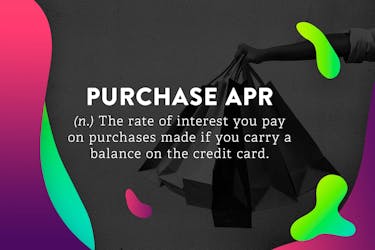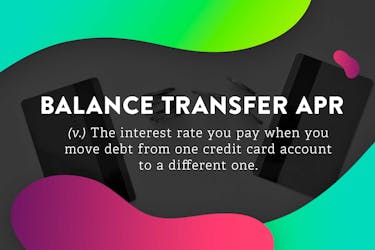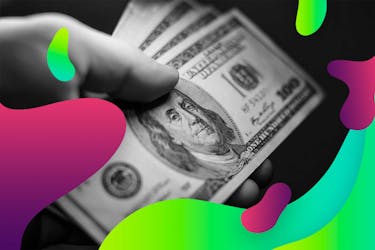

Get Access to 250+ Online Classes
Learn directly from the world’s top investors & entrepreneurs.
Get Started NowIn This Article
- What is APR for Credit Cards? Why Does it Exist?
- What Affects The APR You Pay On A Credit Card?
- Fixed Vs Variable APR
- Different Types of APR’s
- What is the Average APR on a Credit Card?
- What Are Considered Low and High APR’s?
- How Is Credit Card Interest Calculated Each Billing Period?
- How to Check APR On A Credit Card—And Lower It
- How To Negotiate for a Lower APR on a Credit Card
- Final Thoughts About APR On A Credit Card
While shopping for a credit card or examining your monthly credit card bills, you’ve seen and heard of the term APR—the price you pay for borrowing money. But how does it work? Are you paying a high APR? And can you can have a say in how much you interest you pay? (Hint: the answer is yes!)
APR—Annual Percentage Rate—represents the actual yearly cost of servicing a form of interest-accruing debt, including credit cards, auto loans, mortgages, or student loans. In addition to the interest charged, origination fees and other charges can also be included in the APR.
What is APR for Credit Cards? Why Does it Exist?
Credit agreements vary in terms of interest rate structure, transaction fees, late penalties, and other factors. APR on a credit card is a standardized computation providing borrowers with a bottom-line number they can use to compare rates charged by other lenders.
Lenders must show customers the APR on a credit card to help them understand the actual rates that apply to the product they are agreeing to.
One problem is that the APR on a credit card is often advertised as a wide range of possible interest rates—including maximum APR’s that are 7-10% higher than minimum rates.
If a lender offers a credit card with a variable APR of 17.24-25.99%, what rate will you actually pay?
Without actually applying for the card, it’s hard for a customer to predict their APR for the credit card unless they have an excellent credit score. While it might not seem like it’s a big deal to pay 22% instead of 20%, the bigger your balance, the bigger your payments will be.
Knowing the APR on a credit card can help you identify a high interest rate and instead choose a lower rate with a different company.
What Affects The APR You Pay On A Credit Card?
Having an excellent credit score reduces the risk involved for the lender doing business with you. With a credit score over 800, you’re likely to be offered an APR on a credit card at the low end of the advertised range.
The APR on a credit card offer will be higher for less creditworthy borrowers. If you miss loan payments, max out credit card limits, don’t pay monthly minimums, and have unpaid bills or judgments against you, then you’ll pay the highest APR credit card companies can charge.
And that’s if they approve you for a card in the first place.
If you pay your credit card balance in full each month before the due date, the APR on a credit card won’t have any effect on you—you’ll only pay for the charges you put on the card because no interest will accrue.

Fixed Vs Variable APR
Another thing to be aware of is that the APR you’re charged on debt is either fixed or variable.
Don’t be tricked into thinking a “fixed” APR never changes. It just means the rate isn’t tied to an index interest rate, such as the prime rate. A fixed APR on a credit card can be increased with 45 days notification in advance of the rate increase.
A variable APR can change without notice if the index interest rate changes. Both types of credit card APR can change if you do not make payments according to the terms and conditions in your credit card agreement.
Different Types of APR’s
We know the APR on a credit card can be fixed or variable. But other types of APR’s apply in different situations.
While each of the types of APR must be listed in the credit card disclosure, the fine print of the terms and conditions of credit card agreements rarely gets read. Because of this, let’s take a look at important terms to know.
Purchase APR

The rate of interest you pay on purchases made if you carry a balance on the credit card.
Promotional APR

A low-interest rate on a credit card offered on your credit card balance for a specified period.
Balance Transfer APR

The interest rate you pay when you move debt from one credit card account to a different one.
Penalty APR
An extremely high rate (on average 30%) a creditor can charge you for falling significantly behind on your payments. A promotional rate can also be wiped out if you must pay a penalty APR.
Cash Advance APR

This is a high rate of interest paid when you borrow cash on the credit card account. Promotional APR’s don’t usually apply to cash advances.
It’s not too difficult to understand the distinct types of APR on a credit card. But users make mistakes sometimes. Forgetting when a promotional period ends can result in higher interest payments than planned. Cash advances to make a purchase or pay a bill also come with steep interest costs if you can’t pay the money back quickly.
If you don’t know or aren’t sure when a specific type of APR on a credit card applies, check your card disclosure statement, or call customer service. The longer you wait to figure out what interest rate you’re paying and why, the more it can cost you.
What is the Average APR on a Credit Card?
According to recent Federal Reserve data, the average APR across all credit card accounts is over 15 percent—the highest rate recorded in the last 15 years.
A recent survey of new credit card offers by CreditCards.com found average card APR’s approaching a record high of 18 percent.
Retail store cards have much higher APR’s, and everyone usually pays the same rate, regardless of their credit score. A 2018 Retail Store Card Survey found the average median APR for retail cards is over 25 percent.
Think twice before applying for store cards. If you can’t pay off the balance when it’s due, the exceptionally high APR you’re charged can wipe out any benefits or bonuses from applying for and keeping the store card.
The APR on credit card offers from credit unions tends to be some of the lowest offered by lenders. Those with strong credit can sometimes land cards with interest rates near or below 10%. People with less than desirable credit might even get secured or low spending limit credit card offers with APR’s less than the national average from a credit union.
What Are Considered Low and High APR’s?
If you’re wondering what a good or low APR on a credit card is for you, remember it all depends on your credit score. Because your credit score depends on your credit habits, and if you practice them wisely, you can effect to some extent how much of an APR you pay.
Someone with excellent credit might get APR offers of 12% or less from major financial institutions. But if they choose credit cards with big sign-up bonuses or many perks, they may still have average or above APR’s.
Those with credit scores at the fair to poor level (580 or below) always pay APR’s at the top of the range available for a given credit card. When lender’s take significant risks providing credit to people with poor financial histories, they make them pay for it month after month.
With rates in the 24-29% APR range, it can be very difficult to pay off credit card balances each month.
How Is Credit Card Interest Calculated Each Billing Period?
When you can’t pay your balance in full at the end of a billing period, you’ll be charged some amount of interest based on APR on a credit card.
While many companies will show you how much interest has been accrued, it’s important to understand how the interest is calculated. In this example, we’ll use an interest rate of 20% APR to make the calculations easier.
Let’s say you start the new 30-day billing period with a balance of $1,000 on your credit card account. Since you are trying to avoid adding to your debt, you don’t make any purchases with the card until the 16th day of the billing period, and then you add a $100 purchase. You make another purchase on the 20th day of the billing cycle for $200. On the 28th day of the billing cycle, you make one more charge of $100.
You don’t make any payments to your account at all during the month, so your statement balance at the end of the billing period is $1,400.
Credit card interest works on what’s called the average daily balance method. You take each day’s total balance for that billing period and add them all together.
In our example,
- Days 1-15 had a balance of $1,000 (15 days x $1,000)
- Days 16-19 had a balance of $1,100 (4 days x $1,100)
- Days 20-27 had a balance of $1,300 (8 days x $1,300)
- Days 28-30 of the billing cycle had a balance of $1,400 (3 days x $1,400)
When you add them all together, you get a total balance of $34,000. Dividing $34,000 by 30 (the number of days in the billing period) leaves you with an average daily balance of approximately $1,133.
The next step is to figure out how much interest you’ll be charged on that amount of money.
Take the APR on the credit card and divide it by 365 days. This gives you the daily interest rate charge. In our example, 20% APR divided by 365 days is a daily interest rate of approximately .00055%.
The daily interest rate is then multiplied by the number of days in the billing period. If you take .00055% x 30 days, the interest rate for that billing cycle is 1.65%.
The final step is to multiply the billing cycle interest rate by your average daily balance.
In our example, 1.65% x $1,133 = $18.69 is what you will be charged in interest for the billing cycle.
How to Check APR On A Credit Card—And Lower It
Knowing the APR makes it easier to compare the cost of carrying balances on credit cards because you can easily see which one would be cheaper to use just by comparing rates.
To check the APR on your account, look through the credit card agreement. This information should be easy to find and clearly stated. If you can’t find your original agreement, you can also look for APR information on your paper or online billing statements. A customer service agent should also be able to explain the different APR’s that apply to your account.
The easiest way to decrease interest on your credit cards is to pay your balance off in full before the due date each month. You pay 0% interest when you don’t carry a balance—but this doesn’t change your APR.
Since 55% of U.S. adults who have credit cards report also having debt, trying to lower the APR they are paying is crucial if they want to pay off their balances.
So, what should they do? You’ve heard the saying “the squeaky wheel gets the grease” and it’s no different when it comes to credit card interest rates. Lending institutions are not going to offer you lower rates or tell you that a phone call to them might be all it takes for you to save money on interest payments.
Will a call to customer service always get the APR on a credit card reduced? It’s not that easy. While interest rates are not set in stone, there’s little reason for a lender to lose the extra money you’ve been paying to carry a balance month to month.
But that doesn’t mean you shouldn’t ask. If you make payments on time and you’ve been a loyal customer, what could it hurt to inquire about a drop in your rate? A few minutes on the phone can save you hundreds—even thousands—of dollars in interest.

How To Negotiate for a Lower APR on a Credit Card
It’s helpful to have a “script” to follow when you call to ask for a lower APR on a credit card. You can expect the first person you ask about lowering your rate has been told to say no to any such requests.
If your payment history or credit score could use improvement, they likely won’t make any exceptions and reduce your rate. If that happens, thank them and commit to making payments on time and doing what you can to boost your credit score. Then retry lowering your rate in a few months.
If you are a model customer, introduce yourself and tell the representative how long you’ve been loyal to the lender. Ask if there’s a lower interest rate available on your account based on your payment history.
If they offer you a lower rate but not what you want, be ready to ask for a supervisor to negotiate.
Tell the supervisor about offers you’re getting in the mail with lower APR’s and let them know the rate you’re looking for. Ask them to match the other offers because you are a good customer. You can also share the interest rates of personal loans you may have researched.
If they won’t lower the APR on your credit card to the percent you want, you can threaten to close your account and go elsewhere for a new card or loan.
Just be sure you’ve done your homework on other offers and have a plan to pay off any outstanding balance if they close your account. Closing an account can negatively affect your credit score, which can be a big problem too.
There's one more thing you can do to save money if the lender won’t lower the APR on a credit card and you carry a balance on a card.
Make multiple payments on the credit card each month to reduce the daily average balance on the account. You’ll accrue less interest on a lower average balance.
Bonus Tip
While it isn’t right for everyone, another way to save money on interest is to perform a balance transfer.
Final Thoughts About APR On A Credit Card
If you ever carry a balance on your credit card at the end of a billing cycle, APR is a big deal to you. Credit card companies make significant money off people who can’t pay their balances in full each month.
Make sure you understand the APR on your credit cards and the various types of APR you may be charged on your account. If you’re quick to check the box that you’ve read the fine print, at least take the time to learn about interest rates, fees, and other charges you’ll pay when using your credit card.
No one is asking you to read every word, but not understanding the terms of your credit card agreement often results in more money left in your bank account each month. High-interest payments can overwhelm even the best of budgets.
If you're facing high-interest credit cards and increasing monthly balances, there is a way out. Learn these strategies from credit experts to take control of your debt today.






